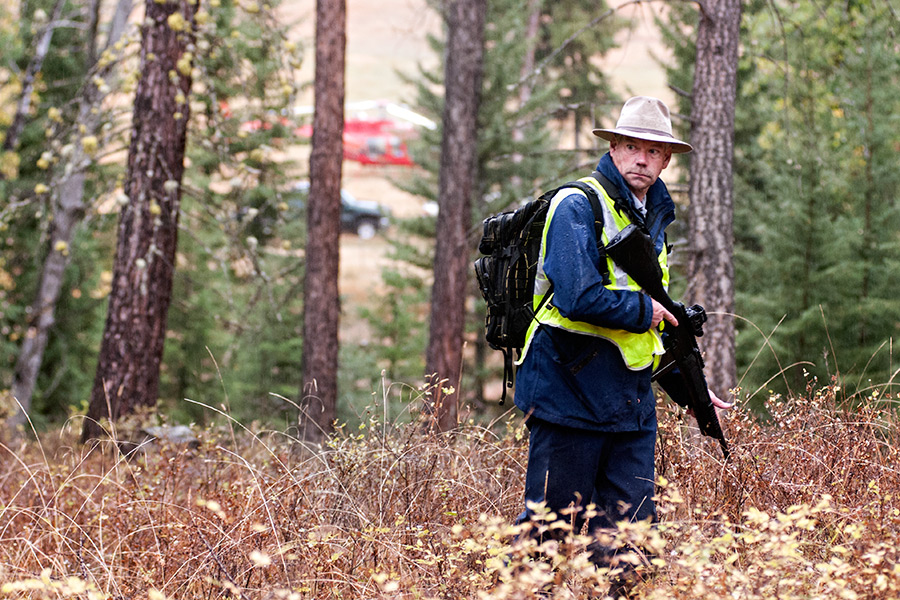Grizzly and black bears are roaming the Flathead Valley in greater abundance as they prepare to den up for the winter, scouring the valley floor for lower-elevation food sources after exhausting this year’s scant supply of berries.
The bears’ seasonal sate is known as “hyperphagia,” but this year’s drought has led to a dearth of natural foods. Meanwhile, as the ever-expanding human-wildlife interface continues to overlap, the bears are increasingly running into conflict with people, exasperating wildlife officials who urge residents in bear country to reduce conflicts by taking simple steps, like picking their fruit trees, locking up trash and storing pet and livestock feed indoors.
“This has been an extremely busy year,” Erik Wenum, bear and lion specialist with the Montana Fish, Wildlife and Parks, said. “We are receiving an average of 35 to 45 calls per day. They’re everywhere – downtown Whitefish, Kalispell, Columbia Falls. All the bears are at low elevations now and they’re looking far and wide for trash, birdseed and of course the ever-present fruit trees.”
The potential for conflicts to become dangerous and even fatal was underscored recently in a spate of bear attacks, as well as a significant uptick in reports of bear-human conflicts, prompting wildlife managers to warn residents to be more bear aware.
On Oct. 1, an elderly woman died from injuries she suffered days earlier when a black bear mauled her inside her home near Ashley Lake, where bears had been “extensively fed,” according to Wenum. Following the attack, investigators uncovered evidence that people were continuing to feed bears near the property.
Although investigators have not been able to capture the bear responsible for the attack, they’ve trapped and killed two other food-conditioned bears near the property, and expressed frustration over the blatant disregard for the law, for public safety, and for the bears.
“It’s an ongoing problem, and it’s hard to gauge whether the public is getting better. I get very frustrated, and it doesn’t seem like the PSAs or education are doing anything. It is a very easy, common-sense fix,” he said.
The same week of the fatal attack, a hiker in Glacier National Park was grabbed and shaken by a grizzly bear, but managed to deploy his bear spray and haze the bear off. Then, on Oct. 3, a bow hunter was attacked by a grizzly northwest of Choteau, and staved off a more vicious attack by jamming his arm down the bear’s throat.
The period from mid-September until grizzly bears den in November is typically a busy time for bear conflict specialists, Wenum said, but this year has been especially problematic.
And while residents can take action to stem the rate of human-bear conflicts, the root of the problem is actually a pair of success stories. As community boosters and tourism bureaus succeed in making Montana a destination place, and conservationists have succeeded in multiplying grizzly populations, there are more people and bears trying to co-exist on the landscape.
Forty years ago, when grizzly bears were given protections under the Endangered Species Act, no more than 500 roamed the region, and Flathead County’s human population hadn’t cracked 45,000 while annual visitation to Glacier National Park hovered at about 1 million.
Today, an estimated 1,000 grizzlies call the area home, Flathead County is filled with more than 90,000 people, and park travel has more than doubled.
More bears, and more people living and playing in bear habitat, is a recipe for a collision course, said Chris Servheen, grizzly bear recovery coordinator for the U.S. Fish and Wildlife Service
Still, the best way to avoid conflicts with bears is through prevention, and wildlife officials are reminding people to remove their birdfeeders until bears have denned, and not to leave garbage, pet food or grain outside. Electric fencing can be used to protect your poultry, beehives and fruit trees. Pick your fruit as soon as it is ripe.
Contact Montana Fish, Wildlife and Parks if you have a bear conflict or need information or assistance on securing attractants. You can get more information at fwp.mt.gov/fishAndWildlife/livingWithWildlife/beBearAware.
